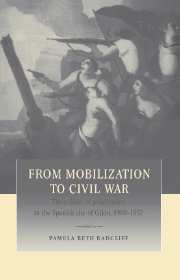Book contents
- Frontmatter
- Contents
- List of maps
- List of tables
- Acknowledgments
- Glossary of terms and abbreviations
- Introduction
- 1 A turning point: the city in 1900
- PART I Patterns of life in working-class Gijón
- PART II Institutional forces of opposition: republicans and anarchosyndicalists
- PART III Defining an oppositional culture: the struggle over the public sphere
- PART IV The urban battlefield: conflict and collective action, 1901–1936
- Conclusion
- Appendix 1 Wage and price movement
- Appendix 2 Occupations by status category
- Appendix 3 Supplementary tables
- Select bibliography
- Index
PART I - Patterns of life in working-class Gijón
Published online by Cambridge University Press: 31 October 2009
- Frontmatter
- Contents
- List of maps
- List of tables
- Acknowledgments
- Glossary of terms and abbreviations
- Introduction
- 1 A turning point: the city in 1900
- PART I Patterns of life in working-class Gijón
- PART II Institutional forces of opposition: republicans and anarchosyndicalists
- PART III Defining an oppositional culture: the struggle over the public sphere
- PART IV The urban battlefield: conflict and collective action, 1901–1936
- Conclusion
- Appendix 1 Wage and price movement
- Appendix 2 Occupations by status category
- Appendix 3 Supplementary tables
- Select bibliography
- Index
Summary
From the late nineteenth century to the Civil War, Gijón's political climate was transformed, from a model of Restoration order to a hotbed of radicalism. Much of this transformation depended on the politicization and participation of the large working-class population, many of them recently arrived on the scene in 1900. The forces of opposition, both republicans and anarchists, targeted this population as the most marginalized and discontented, and thus the most likely to join the struggle against the old regime. Their numbers were such that without them, no popular oppositional movement could have rooted itself in the city. Thus, at a basic constituency level, the working-class population was at the fulcrum of Gijón's political evolution in the twentieth century. Before attempting to interpret that evolution, it makes sense to begin with an analysis of the collective life experience of this new political and social force. The following two chapters will explore the patterns of life in working-class Gijón, and their relationship to the political evolution of the city.
The presumption of links between “patterns of life” and political behavior does not imply a deterministic connection. Instead, the economic, social and cultural conditions of daily life provide a context in which political choices get made. The context then encourages or discourages certain types of responses, from solidarity to fragmentation, from integration to polarization, from conservatism to radicalization. But this context is only one factor in the equation. Equally important is the existing political dynamic, and the ways in which it dialectically reinforces or undermines lessons drawn from the patterns of daily life.
- Type
- Chapter
- Information
- From Mobilization to Civil WarThe Politics of Polarization in the Spanish City of Gijón, 1900–1937, pp. 59 - 61Publisher: Cambridge University PressPrint publication year: 1997

